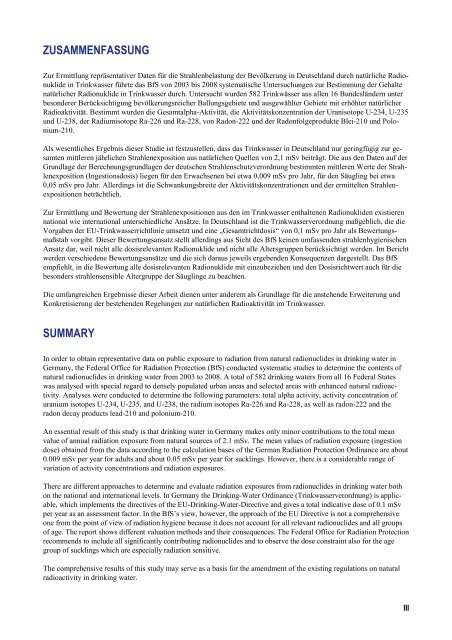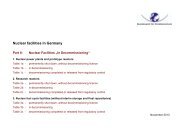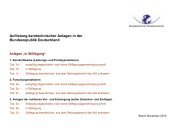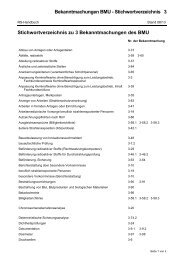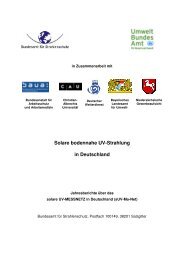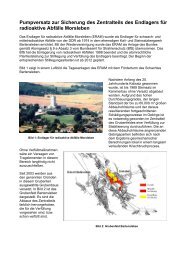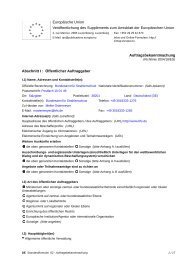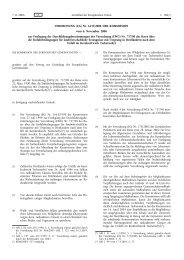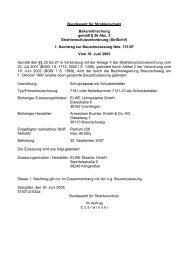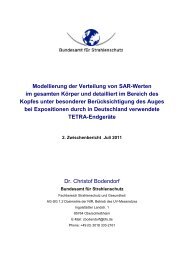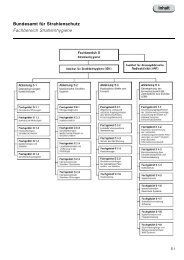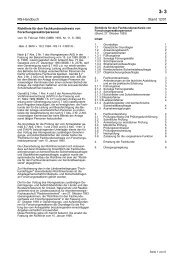Strahlenexposition durch natürliche Radionuklide im Trinkwasser in ...
Strahlenexposition durch natürliche Radionuklide im Trinkwasser in ...
Strahlenexposition durch natürliche Radionuklide im Trinkwasser in ...
Sie wollen auch ein ePaper? Erhöhen Sie die Reichweite Ihrer Titel.
YUMPU macht aus Druck-PDFs automatisch weboptimierte ePaper, die Google liebt.
ZUSAMMENFASSUNG<br />
Zur Ermittlung repräsentativer Daten für die Strahlenbelastung der Bevölkerung <strong>in</strong> Deutschland <strong>durch</strong> <strong>natürliche</strong> <strong>Radionuklide</strong><br />
<strong>in</strong> <strong>Tr<strong>in</strong>kwasser</strong> führte das BfS von 2003 bis 2008 systematische Untersuchungen zur Best<strong>im</strong>mung der Gehalte<br />
<strong>natürliche</strong>r <strong>Radionuklide</strong> <strong>in</strong> <strong>Tr<strong>in</strong>kwasser</strong> <strong>durch</strong>. Untersucht wurden 582 Tr<strong>in</strong>kwässer aus allen 16 Bundesländern unter<br />
besonderer Berücksichtigung bevölkerungsreicher Ballungsgebiete und ausgewählter Gebiete mit erhöhter <strong>natürliche</strong>r<br />
Radioaktivität. Best<strong>im</strong>mt wurden die Gesamtalpha-Aktivität, die Aktivitätskonzentration der Uranisotope U-234, U-235<br />
und U-238, der Radiumisotope Ra-226 und Ra-228, von Radon-222 und der Radonfolgeprodukte Blei-210 und Polonium-210.<br />
Als wesentliches Ergebnis dieser Studie ist festzustellen, dass das <strong>Tr<strong>in</strong>kwasser</strong> <strong>in</strong> Deutschland nur ger<strong>in</strong>gfügig zur gesamten<br />
mittleren jährlichen <strong>Strahlenexposition</strong> aus <strong>natürliche</strong>n Quellen von 2,1 mSv beiträgt. Die aus den Daten auf der<br />
Grundlage der Berechnungsgrundlagen der deutschen Strahlenschutzverordnung best<strong>im</strong>mten mittleren Werte der <strong>Strahlenexposition</strong><br />
(Ingestionsdosis) liegen für den Erwachsenen bei etwa 0,009 mSv pro Jahr, für den Säugl<strong>in</strong>g bei etwa<br />
0,05 mSv pro Jahr. Allerd<strong>in</strong>gs ist die Schwankungsbreite der Aktivitätskonzentrationen und der ermittelten <strong>Strahlenexposition</strong>en<br />
beträchtlich.<br />
Zur Ermittlung und Bewertung der <strong>Strahlenexposition</strong>en aus den <strong>im</strong> <strong>Tr<strong>in</strong>kwasser</strong> enthaltenen <strong>Radionuklide</strong>n existieren<br />
national wie <strong>in</strong>ternational unterschiedliche Ansätze. In Deutschland ist die <strong>Tr<strong>in</strong>kwasser</strong>verordnung maßgeblich, die die<br />
Vorgaben der EU-<strong>Tr<strong>in</strong>kwasser</strong>richtl<strong>in</strong>ie umsetzt und e<strong>in</strong>e „Gesamtrichtdosis“ von 0,1 mSv pro Jahr als Bewertungsmaßstab<br />
vorgibt. Dieser Bewertungsansatz stellt allerd<strong>in</strong>gs aus Sicht des BfS ke<strong>in</strong>en umfassenden strahlenhygienischen<br />
Ansatz dar, weil nicht alle dosisrelevanten <strong>Radionuklide</strong> und nicht alle Altersgruppen berücksichtigt werden. Im Bericht<br />
werden verschiedene Bewertungsansätze und die sich daraus jeweils ergebenden Konsequenzen dargestellt. Das BfS<br />
empfiehlt, <strong>in</strong> die Bewertung alle dosisrelevanten <strong>Radionuklide</strong> mit e<strong>in</strong>zubeziehen und den Dosisrichtwert auch für die<br />
besonders strahlensensible Altergruppe der Säugl<strong>in</strong>ge zu beachten.<br />
Die umfangreichen Ergebnisse dieser Arbeit dienen unter anderem als Grundlage für die anstehende Erweiterung und<br />
Konkretisierung der bestehenden Regelungen zur <strong>natürliche</strong>n Radioaktivität <strong>im</strong> <strong>Tr<strong>in</strong>kwasser</strong>.<br />
SUMMARY<br />
In order to obta<strong>in</strong> representative data on public exposure to radiation from natural radionuclides <strong>in</strong> dr<strong>in</strong>k<strong>in</strong>g water <strong>in</strong><br />
Germany, the Federal Office for Radiation Protection (BfS) conducted systematic studies to determ<strong>in</strong>e the contents of<br />
natural radionuclides <strong>in</strong> dr<strong>in</strong>k<strong>in</strong>g water from 2003 to 2008. A total of 582 dr<strong>in</strong>k<strong>in</strong>g waters from all 16 Federal States<br />
was analysed with special regard to densely populated urban areas and selected areas with enhanced natural radioactivity.<br />
Analyses were conducted to determ<strong>in</strong>e the follow<strong>in</strong>g parameters: total alpha activity, activity concentration of<br />
uranium isotopes U-234, U-235, and U-238, the radium isotopes Ra-226 and Ra-228, as well as radon-222 and the<br />
radon decay products lead-210 and polonium-210.<br />
An essential result of this study is that dr<strong>in</strong>k<strong>in</strong>g water <strong>in</strong> Germany makes only m<strong>in</strong>or contributions to the total mean<br />
value of annual radiation exposure from natural sources of 2.1 mSv. The mean values of radiation exposure (<strong>in</strong>gestion<br />
dose) obta<strong>in</strong>ed from the data accord<strong>in</strong>g to the calculation bases of the German Radiation Protection Ord<strong>in</strong>ance are about<br />
0.009 mSv per year for adults and about 0.05 mSv per year for suckl<strong>in</strong>gs. However, there is a considerable range of<br />
variation of activity concentrations and radiation exposures.<br />
There are different approaches to determ<strong>in</strong>e and evaluate radiation exposures from radionuclides <strong>in</strong> dr<strong>in</strong>k<strong>in</strong>g water both<br />
on the national and <strong>in</strong>ternational levels. In Germany the Dr<strong>in</strong>k<strong>in</strong>g-Water Ord<strong>in</strong>ance (<strong>Tr<strong>in</strong>kwasser</strong>verordnung) is applicable,<br />
which <strong>im</strong>plements the directives of the EU-Dr<strong>in</strong>k<strong>in</strong>g-Water-Directive and gives a total <strong>in</strong>dicative dose of 0.1 mSv<br />
per year as an assessment factor. In the BfS’s view, however, the approach of the EU Directive is not a comprehensive<br />
one from the po<strong>in</strong>t of view of radiation hygiene because it does not account for all relevant radionuclides and all groups<br />
of age. The report shows different valuation methods and their consequences. The Federal Office for Radiation Protection<br />
recommends to <strong>in</strong>clude all significantly contribut<strong>in</strong>g radionuclides and to observe the dose constra<strong>in</strong>t also for the age<br />
group of suckl<strong>in</strong>gs which are especially radiation sensitive.<br />
The comprehensive results of this study may serve as a basis for the amendment of the exist<strong>in</strong>g regulations on natural<br />
radioactivity <strong>in</strong> dr<strong>in</strong>k<strong>in</strong>g water.<br />
III


